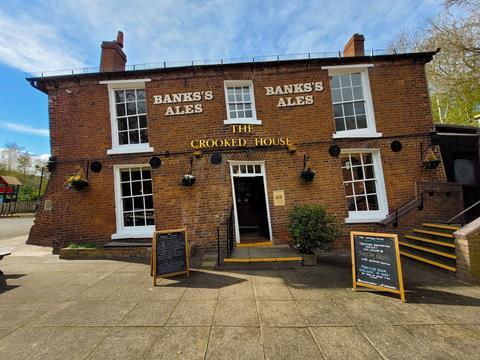Any attempt to rebuild the Crooked House would merely produce a ‘worthless fake’, writes Joe Holyoak

It is extraordinary how the demolition in August of the Crooked House pub in Himley, South Staffordshire, caught the public imagination. For a long time, “the wonkiest pub in Britain” was celebrated locally as a West Midlands curiosity, but its demise has been widely reported in the national press and television, and even reached the pages of the New York Times.
The frequency with which empty and unwanted buildings catch fire is remarkable. Two days after the fire at the Crooked House, there was a fire at another unwanted historic building, Smallbrook Ringway in Birmingham, which I wrote about recently here.
The Crooked House scandal grew from that initial mysterious fire – and the inability of fire crews to reach it because of a large pile of spoil dumped in their route – to the subsequent illegal demolition of the remaining brickwork shell. The tabloid press soon started depicting the building’s owners, who had recently bought it from Marstons brewery, as high-living villains, photographed “posing outside the famous seven-star Burj Al Arab hotel during a trip to Dubai… and driving a Bentley.”
The word crooked gained a wider resonance, and the story became a classic media sensation.
Unsurprisingly, in all the media coverage there was not much said about the wider context of how the demolition of empty buildings, and their replacement by new buildings, contributes to the carbon crisis. I have not spotted the word retrofit in any news reports. Old pubs feature prominently in this context, as so many have closed in recent years, due to a combination of reasons including Covid and increased beer prices.
Unless a building is statutorily listed or in a conservation area, which the Crooked House was not, it is quite easy and tempting to get permission to demolish. Even if the demolition was done illegally without permission from the local planning authority, which seems to have happened in this case, the fines are usually minor compared with the profit which can follow.
A rebuilt Crooked House would of course be a worthless fake, a travesty of the original
The publicity which the Crooked House case has received has been because of the pub’s novelty value. The demolition of an unlisted 1765 Georgian farmhouse would not normally excite so much interest.
The reason that this one has is only because it sloped so that one end of it was a metre lower than the other, due to subsidence caused by the Himley Colliery workings in the 19th century. But it has led some commentators to argue that there needs to be greater control over demolition.
The argument is for sentimental reasons related to the unhappy loss of a well-loved novelty building. But it would not be the first time that the right argument was advanced for the wrong reasons. Someone should trace the dots which connect the Crooked House and Marks and Spencer in London’s Oxford Street, and join the two together.

The Mayor of the West Midlands Combined Authority, Andy Street, has stepped into the controversy, expressing his outrage over the demolition, saying that the pub “must not be consigned to history”, and calling on South Staffordshire Council to enforce its rebuilding. (It is not clear to me why he is involved, as South Staffordshire is beyond his West Midlands Combined Authority boundary. I suspect he has seen an opportunity for some populist engagement).
A rebuilt Crooked House would of course be a worthless fake, a travesty of the original. Presumably the large brickwork buttresses would be rebuilt, although the sloping replica, faithfully reproducing the 16 degree tilt of the original, would be made structurally stable without them.
To believe that a building that has disappeared can be restored is fallacious thinking. Restoration means, as John Ruskin said, “the most total destruction which a building can suffer: a destruction out of which no remnants can be gathered: a destruction accompanied with false description of the thing destroyed”.
William Morris got it right in his manifesto for the Society for the Protection of Ancient Buildings: “We plead ….. to put Protection in the place of Restoration”. The Crooked House is gone, like thousands of other fine buildings. It can’t be reinvented.
The appropriate response is to prosecute those who illegally demolished it, and to put in place stronger and more effective legislation that would give unlisted buildings a greater protection against irresponsible demolition, and at the same time give a bit of help to the world in fighting the climate emergency.
>> Also read: The loss of the Crooked House pub reveals that built heritage is about a lot more than buildings
Postscript
Joe Holyoak is an architect and urban designer practising in Birmingham
















5 Readers' comments